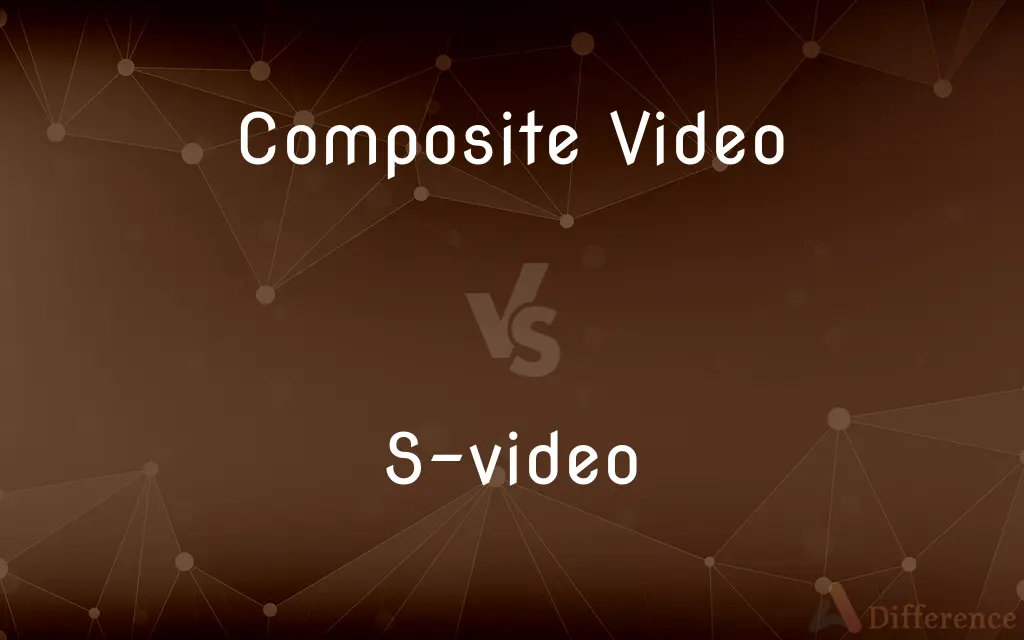Composite Video vs. S-video — What's the Difference?
By Tayyaba Rehman — Published on February 11, 2024
Composite Video and S-video are video signal formats. Composite combines all signals into one, potentially degrading quality. S-video separates signals, providing better quality by keeping brightness and color information separate.

Difference Between Composite Video and S-video
Table of Contents
ADVERTISEMENT
Key Differences
Composite Video, a common connection, combines all video signals into one cable. It transmits video, sync, and color information through a single channel, but this amalgamation can result in signal interference and reduced picture quality.
S-video, or Separate Video, improves on Composite by transmitting brightness (luminance) and color (chrominance) signals separately. This separation reduces signal interference and enhances image quality. S-video connectors have separate pins for luminance and chrominance, ensuring clearer and sharper visuals.
Composite Video suffers from color bleeding, where color information can bleed into areas of the image. S-video's separation of luminance and chrominance signals prevents color bleeding, resulting in sharper images, especially noticeable on high-resolution displays.
In terms of cable complexity, Composite uses a single cable, simplifying connections, but at the cost of potential signal degradation. S-video, with separate luminance and chrominance cables, provides a cleaner signal but requires additional cables for connection.
While Composite Video is widely compatible, found in many consumer devices, S-video is commonly used in higher-end equipment, offering improved image quality, making it preferred for professional audiovisual setups.
ADVERTISEMENT
Comparison Chart
Signal Transmission
Combines video, sync, and color signals
Separates luminance and chrominance signals
Image Quality
Prone to interference, potential degradation
Improved quality, reduced signal interference
Color Bleeding
Susceptible to color bleeding
Prevents color bleeding, sharper images
Cable Complexity
Single cable for all signals
Separate cables for luminance and chrominance
Device Compatibility
Widely compatible in consumer devices
Commonly used in higher-end audiovisual setups
Compare with Definitions
Composite Video
Common Connection Type: Composite Video is a common connection.
Composite Video is commonly found in older TVs and is a basic video connection option.
S-video
Reduced Signal Interference: S-video reduces signal interference.
The separate transmission in S-video minimizes signal interference, providing a cleaner and clearer video output.
Composite Video
Potential Signal Degradation: Composite Video may suffer signal degradation.
Using Composite Video, there's a risk of signal degradation due to the amalgamation of various signals.
S-video
Color Bleeding Prevention: S-video prevents color bleeding.
Unlike Composite Video, S-video prevents color bleeding, ensuring sharper and more defined images.
Composite Video
Color Bleeding Issues: Composite Video can experience color bleeding.
Color bleeding is a common issue with Composite Video, where color information may bleed into adjacent areas.
S-video
Additional Cable Complexity: S-video uses separate cables.
S-video requires separate cables for luminance and chrominance, offering improved quality but adding to cable complexity.
Composite Video
Single Cable Transmission: Composite Video combines signals into one cable.
Composite Video uses a single cable to transmit video, sync, and color information.
S-video
Professional Audiovisual Usage: S-video is common in professional setups.
S-video is often preferred in professional audiovisual setups, providing superior image quality compared to Composite Video.
Composite Video
Consumer Device Compatibility: Composite Video is widely compatible.
Most consumer devices, like DVD players and gaming consoles, support Composite Video connections.
S-video
Separate Luminance and Chrominance: S-video separates signals.
S-video transmits video signals by separating luminance and chrominance, resulting in improved image quality.
Common Curiosities
How does Composite Video transmit signals?
Composite Video transmits video, sync, and color information through a single channel.
What is Composite Video?
Composite Video is a video signal format that combines video, sync, and color signals into a single cable.
Which connection type uses a single cable for transmission?
Composite Video uses a single cable for transmitting video, sync, and color signals.
What issue does Composite Video commonly experience with color?
Composite Video is susceptible to color bleeding, where color information can bleed into adjacent areas of the image.
How does S-video prevent color bleeding?
S-video prevents color bleeding by separating luminance and chrominance signals, ensuring distinct and sharp color representation.
Is Composite Video widely compatible with consumer devices?
Yes, Composite Video is widely compatible and can be found in most consumer devices.
What is a potential disadvantage of Composite Video in terms of cable complexity?
While Composite Video simplifies connections with a single cable, it may result in potential signal degradation.
What is a drawback of Composite Video in terms of signal quality?
Composite Video is prone to interference, potentially leading to signal degradation.
What is S-video?
S-video, or Separate Video, is a video signal format that separates luminance and chrominance signals for improved image quality.
How does S-video improve image quality?
S-video improves image quality by separating brightness (luminance) and color (chrominance) signals, reducing interference.
What is the main advantage of S-video over Composite Video?
The main advantage of S-video over Composite Video is its ability to separate luminance and chrominance, reducing signal interference.
What does S-video use separate cables for?
S-video uses separate cables for transmitting luminance and chrominance signals, ensuring improved image quality.
Which signal format is considered common in higher-end audiovisual setups?
S-video is commonly used in higher-end audiovisual setups due to its superior image quality compared to Composite Video.
Which video signal format is considered a basic connection option?
Composite Video is considered a basic video connection option, commonly used in various consumer devices.
In what scenarios might Composite Video be commonly found?
Composite Video is commonly found in older consumer devices, such as older TVs, VCRs, and gaming consoles.
Share Your Discovery

Previous Comparison
E*TRADE vs. Scottrade
Next Comparison
Calories vs. CarbsAuthor Spotlight
Written by
Tayyaba RehmanTayyaba Rehman is a distinguished writer, currently serving as a primary contributor to askdifference.com. As a researcher in semantics and etymology, Tayyaba's passion for the complexity of languages and their distinctions has found a perfect home on the platform. Tayyaba delves into the intricacies of language, distinguishing between commonly confused words and phrases, thereby providing clarity for readers worldwide.
















































